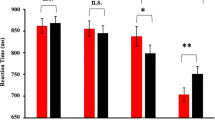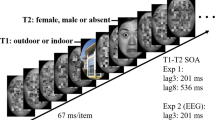Abstract
Fearful faces could be processed preferentially relative to neutral faces. However, it is still unclear whether the advantage of fear depends on temporal attentional resources. We used the “attentional blink” (AB) paradigm to investigate the role of temporal attention in the processing of fear. We manipulated the emotionality (fear, neutral) of the second target (T2), and T1-T2 interval time (lag 3, lag 8). Four experiments were designed to reduce gradually the available attentional resources for emotional T2 by manipulating the number of letters in the letter search task (Experiments 1 and 3) or in the letter working memory task (Experiment 2 and 4) in the T1 task. The results showed that the AB magnitude of fearful T2 was smaller than that of neutral T2, and this effect was not influenced by T1 difficulty in Experiment 1 (letter search task: 1, 2, 4, 6, and 8 letters) and Experiment 2 (letter working memory task: 1, 2, 3, and 4 letters), in which the T2 task was the intact face detection task. In Experiment 3, when the T2 was gender discrimination task, the AB magnitude of fearful T2 was smaller than that of neutral T2 in the low and medium T1- difficulty conditions (2 and 4 letters in the letter search task), but not in the high T1-difficulty condition (6 letters in the letter search task). Experiment 4 was a replication of Experiment 3, but with the working memory T1 task used in Experiment 2. As expected, the results of Experiment 4 replicated the results of Experiment 3 and provided more evidence that the processing advantage of fearful T2 was modulated by T1 difficulty. These results suggested that the priority of fear required attentional resources.



Similar content being viewed by others
Data Availability
The datasets generated and analysed during the current study are available from the corresponding author on reasonable request.
References
Anderson, S. F., Kelley, K., & Maxwell, S. E. (2017). Sample-size planning for more accurate statistical power: A method adjusting sample effect sizes for publication bias and uncertainty. Psychological Science, 28(11), 1547–1562.
Bar-Haim, Y., Lamy, D., Pergamin, L., Bakermans-Kranenburg, M. J., & van, I. M. H. (2007). Threat-related attentional bias in anxious and nonanxious individuals: A meta-analytic study. Psychological Bulletin, 133(1), 1–24. https://doi.org/10.1037/0033-2909.133.1.1
Bruce, V., & Young, A. W. (1986). Understanding face recognition. British Journal of Psychology, 77(3), 305–327.
Burt, J. S., Howard, S., & Falconer, E. K. (2011). T1 difficulty affects the AB: Manipulating T1 word frequency and T1 orthographic neighbor frequency. Attention, Perception, & Psychophysics, 73(3), 751–765. https://doi.org/10.3758/s13414-010-0054-x
Carretie, L. (2014). Exogenous (automatic) attention to emotional stimuli: A review. Cognitive, Affective, & Behavioral Neuroscience, 14(4), 1228–1258. https://doi.org/10.3758/s13415-014-0270-2
Chen, X., Duan, H., Kan, Y., Qi, S., & Hu, W. (2020). Influence of emotional task relevancy on the temporal dynamic of attentional bias in people with high-trait anxiety. Journal of Cognitive Psychology, 32(2), 242–253. https://doi.org/10.1080/20445911.2020.1719115
Chun, M. M., & Potter, M. C. (1995). A two-stage model for multiple target detection in rapid serial visual presentation. Journal of Experimental Psychology: Human Perception and Performance, 21(1), 109. https://doi.org/10.1037/0096-1523.21.1.109
Dalmaso, M., Castelli, L., & Galfano, G. (2020). Social modulators of gaze-mediated orienting of attention: A review. Psychonomic Bulletin & Review, 27(5), 833–855. https://doi.org/10.3758/s13423-020-01730-x
de Jong, P. J., & Martens, S. (2007). Detection of emotional expressions in rapidly changing facial displays in high- and low-socially anxious women. Behaviour Research and Therapy, 45(6), 1285–1294. https://doi.org/10.1016/j.brat.2006.10.003
De Martino, B., Kalisch, R., Rees, G., & Dolan, R. J. (2009). Enhanced processing of threat stimuli under limited attentional resources. Cerebral Cortex, 19(1), 127–133. https://doi.org/10.1093/cercor/bhn062
Desimone, R., & Duncan, J. S. (1995). Neural mechanisms of selective visual attention. Annual Review of Neuroscience, 18(1), 193–222.
Fox, E., Russo, R., & Georgiou, G. A. (2005). Anxiety modulates the degree of attentive resources required to process emotional faces. Cognitive, Affective, & Behavioral Neuroscience, 5(4), 396–404. https://doi.org/10.3758/CABN.5.4.396
Giesbrecht, B., Sy, J. L., & Lewis, M. K. (2009). Personal names do not always survive the attentional blink: Behavioral evidence for a flexible locus of selection. Vision Research, 49(10), 1378–1388. https://doi.org/10.1016/j.visres.2008.02.013
Gupta, R., Hur, Y., & Lavie, N. (2016). Distracted by pleasure: Effects of positive versus negative valence on emotional capture under load. Emotion, 16(3), 328–337.
Hakamata, Y., Lissek, S., Bar-Haim, Y., Britton, J. C., Fox, N. A., Leibenluft, E., et al. (2010). Attention bias modification treatment: A meta-analysis toward the establishment of novel treatment for anxiety. Biological Psychiatry, 68(11), 982–990. https://doi.org/10.1016/j.biopsych.2010.07.021
Huang, S. L., Chang, Y. C., & Chen, Y. J. (2011). Task-irrelevant angry faces capture attention in visual search while modulated by resources. Emotion, 11(3), 544–552. https://doi.org/10.1037/a0022763
Lavie, N. (2005). Distracted and confused?: Selective attention under load. Trends in Cognitive Sciences, 9(2), 75–82.
Ligeza, T. S., & Wyczesany, M. (2017). Cognitive conflict increases processing of negative, task-irrelevant stimuli. International Journal of Psychophysiology, 120, 126–135.
Lim, S., Padmala, S., & Pessoa, L. (2008). Affective learning modulates spatial competition during low-load attentional conditions. Neuropsychologia, 46(5), 1267–1278.
Lindh, D., Sligte, I. G., Assecondi, S., Shapiro, K. L., & Charest, I. (2019). Conscious perception of natural images is constrained by category-related visual features. Nature Communications, 10(1), 4106. https://doi.org/10.1038/s41467-019-12135-3
Macrae, C. N., Hood, B. M., Milne, A. B., Rowe, A. C., & Mason, M. F. (2002). Are you looking at me? Eye gaze and person perception. Psychological Science, 13(5), 460–464. https://doi.org/10.1111/1467-9280.00481
Maratos, F. A., Mogg, K., & Bradley, B. P. (2008). Identification of angry faces in the attentional blink. Cogn Emot, 22(7), 1340–1352. https://doi.org/10.1080/02699930701774218
Mishra, M. V., Ray, S. B., & Srinivasan, N. (2017). Effect of emotions on temporal attention., 236, 287–309. https://doi.org/10.1016/bs.pbr.2017.08.014
Öhman, A. (2005). The role of the amygdala in human fear: Automatic detection of threat. Psychoneuroendocrinology, 30(10), 953–958. https://doi.org/10.1016/j.psyneuen.2005.03.019
Öhman, A., Carlsson, K., Lundqvist, D., & Ingvar, M. (2007). On the unconscious subcortical origin of human fear. Physiology & Behavior, 92(1–2), 180–185.
Pan, F., Shi, L., Lu, Q., Wu, X., Xue, S., & Li, Q. (2016). The negative priming effect in cognitive conflict processing. Neuroence Letters, 35–39.
Pessoa, L., Mckenna, M. J., Gutierrez, E., & Ungerleider, L. G. (2002a). Neural processing of emotional faces requires attention. Proceedings of the National Academy of Sciences, 99(17), 11458–11463. https://doi.org/10.1073/pnas.172403899
Pessoa, L., Mckenna, M. J., Gutierrez, E., & Ungerleider, L. G. (2002b). Neural processing of emotional faces requires attention. Proceedings of the National Academy of Sciences of the United States of America, 99(17), 11458–11463.
Pessoa, L., Padmala, S., & Morland, T. (2005). Fate of unattended fearful faces in the amygdala is determined by both attentional resources and cognitive modulation. Neuroimage, 28(1), 249–255. https://doi.org/10.1016/j.neuroimage.2005.05.048
Raymond, J. E., Shapiro, K. L., & Arnell, K. M. (1992). Temporary suppression of visual processing in an RSVP task: An attentional blink? Journal of Experimental Psychology: Human Perception and Performance, 18(3), 849.
Rigoulot, S., Dhondt, F., Honore, J., & Sequeira, H. (2012). Implicit emotional processing in peripheral vision: Behavioral and neural evidence. Neuropsychologia, 50(12), 2887–2896. https://doi.org/10.1016/j.neuropsychologia.2012.08.015
Sebastian, C. L., Mccrory, E., De Brito, S. A., & Viding, E. (2017). Modulation of amygdala response to task-irrelevant emotion. Social Cognitive and Affective Neuroscience, 12(4), 643–650. https://doi.org/10.1093/scan/nsw174
Shafer, A. T., Matveychuk, D., Penney, T., Ohare, A. J., Stokes, J., & Dolcos, F. (2012). Processing of emotional distraction is both automatic and modulated by attention: Evidence from an event-related fmri investigation. Journal of Cognitive Neuroscience, 24(5), 1233–1252.
Stein, T., Peelen, M. V., Funk, J., & Seidl, K. N. (2010). The fearful-face advantage is modulated by task demands: Evidence from the attentional blink. Emotion, 10(1), 136–140. https://doi.org/10.1037/a0017814
Tanaka, J. W., & Farah, M. J. (1993). Parts and wholes in face recognition. Quarterly Journal of Experimental Psychology, 46(2), 225–245.
Victeur, Q., Huguet, P., & Silvert, L. (2020). Attentional allocation to task-irrelevant fearful faces is not automatic: Experimental evidence for the conditional hypothesis of emotional selection. Cogn Emot, 34(2), 288–301. https://doi.org/10.1080/02699931.2019.1622512
Vromen, J. M., Lipp, O. V., Remington, R. W., & Becker, S. I. (2016). Threat captures attention, but not automatically: Top-down goals modulate attentional orienting to threat distractors. Attention, Perception, & Psychophysics, 78(7), 2266–2279.
Vuilleumier, P., Armony, J., Driver, J., & Dolan, R. J. (2001). Effects of attention and emotion on face processing in the human brain: An event-related fMRI study. Neuron, 30(3), 829–841. https://doi.org/10.1016/S0896-6273(01)00328-2
Whalen, P. J., Raila, H., Bennett, R., Mattek, A., Brown, A., Taylor, J., et al. (2013). Neuroscience and facial expressions of emotion: The role of amygdala–prefrontal interactions. Emotion Review, 5(1), 78–83.
Ye, R., Yu, F., Jiang, Y., & Wang, K. (2011). The impact of perceptual load on emotional face processing in attentional blink paradigm. Acta Psychologica Sinica, 43(05), 483–493.
Acknowledgements
This research was supported by the National Natural Science Foundation of China (31470980) to Qin Zhang and the Youth Beijing Scholar Project to Ping Wei.
Author information
Authors and Affiliations
Contributions
Meng Sun: Writing-Original Draft, Data Curation, Software, Formal analysis.
Xi Jia: Writing - Review & Editing.
Fang Liu: Writing - Review & Editing.
Ping Wei: Writing - Review & Editing.
Lixia Cui: Writing - Review & Editing.
Qin Zhang: Conceptualization, Supervision, Project administration, Funding acquisition.
Corresponding author
Ethics declarations
Conflict of Interest
There are no conflicts of interest.
Additional information
Publisher’s Note
Springer Nature remains neutral with regard to jurisdictional claims in published maps and institutional affiliations.
Rights and permissions
About this article
Cite this article
Sun, M., Jia, X., Liu, F. et al. The role of temporal attention in the processing of facial expression: Evidence from attentional blink paradigm. Curr Psychol 42, 19025–19036 (2023). https://doi.org/10.1007/s12144-021-02500-1
Accepted:
Published:
Issue Date:
DOI: https://doi.org/10.1007/s12144-021-02500-1




